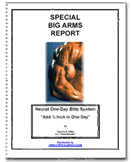
AUDIO/VISUAL
Visitor
#
Since
3 Dec. '02
Click Here For Free Bodybuilding Newsletter
How Good is Your Nutrition?
By Dennis B. Weis "The Yukon Hercules" Most well-respected authorities in the health and fitness industry agree that proper nutrition can greatly accelerate the positive effects of exercise. Larry Scott, the first IFBB Mr. Olympia pro bodybuilding champion, has said on hundreds of occasions that putting on muscle mass is at least 80% nutrition. Actually, when Larry said 80%, he just picked that figure out of the air to emphasize upon the mind set of bodybuilders just how important the nutrition factor is when combined with training. Many individuals simply choose to ignore the importance of the nutrition factor and as a result waste many years of progressive resistance training and with little progress to show. Suffice it to say that some rather dramatic results in strength and cosmetic appearance can be achieved when combining progressive resistance weight-training with an explicitly-calculated nutritional program. A calculated nutritional program will always contain a selected ratio of the macro-nutrients (complex "starches" and simple "fruit" carbohydrates, fats (polyunsaturated, monounsaturated, fish oils), and proteins (vegetable and animal). The macro-nutrient composition ratios can be adjusted to accommodate optimal body-fat weight loss and/or for the gaining of muscle tissue. For example, if your diet composition ratio is 15-19% protein, 58-65% carbohydrate, and 20-23% fat, and you wish to accelerate fat loss, lay off the sugars, decrease your fat intake, and increase the protein intake. Reduce your total daily calorie-dependent intake modestly by two calories per pound of bodyweight a day until you begin seeing a 1 ½ to 2-pound decrease in body-fat loss per week. In the more difficult cases, three and possibly more calories per pound of bodyweight may have to be decreased on a daily basis until weight-loss becomes evident, but never lower your daily calorie intake below 1200-1500 a day!!! The reverse of the above scenario is the individual who has a very fast metabolism and is desperate to put on more muscle mass. For this individual, I suggest including an extra two calories per pound of bodyweight to the daily calorie-dependent intake until the desired results begin to be seen. In some very extreme cases, a gradual increase of eight calories per pound of bodyweight a day over and above the maintenance level is required to see an acceptable muscle gain of one to 1 ½ pounds a month. To accomplish a goal of losing body-fat and/or the gaining of muscle, you must keep track of the ratio of macro-nutrients (complex carbohydrates, fats, and proteins), and daily calories consumed. If you haven’t been keeping track, how can you be sure you are giving your body what it needs to accomplish its goal? To access your current nutritional protocol on a daily basis and with accuracy it is a good idea to keep a detailed record of everything you eat on a daily basis. Weight and measure all foods and record the amounts eaten at each meal. At the end of the week, calculate the total calories, grams of carbohydrates, fats, and proteins, and ratios of each. Figure your average daily calories. If you haven’t gained or lost weight (i.e. muscle and/or body-fat) during the week, then this is your maintenance level. Armed with this information it’s now just a matter of subtracting or adding calories as discussed earlier for achieving the desired body-fat loss or muscle gain effect. Other tools for monitoring progress include and are not limited to the scale and a nylon measuring tape. Weigh yourself once a week, always on the same day, and first thing in the morning. Take measurements of such muscle groups as the arms, chest, waist, thighs, and calves. Try to be consistent as to where the nylon measuring tape is placed and how snugly it is pulled. It is a good idea to note the time of day the measurements are taken. If you can, have someone take photos of you. This is yet another tool for monitoring your progress. As a closing thought, I must admit that analyzing your nutritional intake and the planning-out of your meals on a daily basis will take up some of your personal time, especially if you have to use a calculator and a book of food values. If you have access to a PC, then this job will become a much easier one and a little less complicated. There are now available three nutrition software programs by which you can plan your meals, analyze your diet, and even determine the food values of your own recipes. The first one is called the Computer Nutrition Program CD V2.0. This software (for PC only) has just been introduced by Parrillo Performance (visit www.parrillo.com for more information). The second computer program is Charles Staley’s Training-Nutrition Manager 2.0. This program can for a price of $59.95 be downloaded at www.myodynamics.com. The third nutrition software program is called Diet Power (visit www.dietpower.com and download a free 15-day trial version). Whether you use a pencil and paper, a calculator, or a nutrition software program, take the time to be sure your body is getting what it needs nutritionally. With a maximum performance diet program you will exhibit a very acceptable lean muscle mass-to-fat ratio. You will also experience fewer training injuries because you will be getting enough macro and micro-nutrients to adequately support the repair and recovery of the muscles. |


